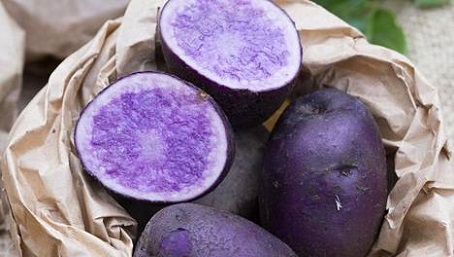Diabetes News: Study From Finland Shows That Anthocyanins From Purple Fruits And Vegetables Helps In Various Issues Associated With Diabetes
Diabetes News - Anthocyanins Mar 26, 2023 2 years, 8 months, 3 weeks, 5 days, 7 hours, 16 minutes ago
Diabetes News: A new study by researchers from University of Turku-Finland has found that anthocyanins from purple fruits and vegetables helps in various issues associated with diabetes.
 Synkeä Sakari -A Finnish purple potato variety abundant in acylated anthocyanins.
Synkeä Sakari -A Finnish purple potato variety abundant in acylated anthocyanins.
Pic Credit: TEIJA TUISKU
Anthocyanins, the pigments responsible for red-orange to blue-violet hues in fruits, vegetables, and tubers, exhibit antidiabetic properties by influencing energy metabolism, inflammation, and gut microbiota.
Interestingly, when the glycosyl components of anthocyanins undergo acylation, their physicochemical attributes and stability are further enhanced.
These acylated anthocyanins have probiotic-like characteristics and reduced bioavailability may produce different biological effects on diabetes compared to their nonacylated counterparts.
The study found various antidiabetic benefits of acylated anthocyanins in relation to energy metabolism, inflammation, and gut microbiota, contrasting them with nonacylated anthocyanins.
Special attention was given to the cellular and molecular mechanisms linked to the advantageous impacts of these bioactive compounds, offering a fresh viewpoint for investigating the varying biological consequences elicited by structurally distinct anthocyanins.
In comparison to nonacylated anthocyanins, acylated anthocyanins might have a more significant impact on energy metabolism, inflammation, and gut microbiota in type 2 diabetes.
The study findings were published in the peer reviewed Journal of Agricultural and Food Chemistry.
https://pubs.acs.org/doi/full/10.1021/acs.jafc.2c05879
Besides the advantageous influence of anthocyanins on diabetes being heightened when they undergo acylation ie the process of attaching an acyl group to the sugar components of the anthocyanin, the study findings also has determined that the likelihood of developing type 2 diabetes can be diminished through the ingestion of anthocyanins. These are the
An abundance of acylated anthocyanins can be found in purple potatoes, purple sweet potatoes, radishes, purple carrots, and red cabbages. In contrast, bilberries and mulberries primarily contain nonacylated anthocyanins. Although acylated anthocyanins are not easily absorbed during digestion, they possess probiotic qualities and are more effective at reducing diabetes risk than nonacylated anthocyanins.
Dr Kang Chen, a Postdoctoral Researcher at the Food Sciences Unit of the University of Turku, Finland, explained to
Diabetes News reporters at TMN that that acylation not only alters the physical and chemical properties of anthocyanins, but also influences how they are absorbed and metabolized within the body. Acylated anthocyanins are more potent antioxidants than their nonacylated counterparts and also enhance the intestinal barrier that facilitates the absorption of essential nutrients. Moreover, acylated anthocyanins help main
tain gut microbiota balance, inhibit pro-inflammatory pathways, and regulate glucose and lipid metabolism.
Dr Chen further clarified that the type of anthocyanins produced by a plant is determined by its genotype. Generally, purple vegetables are rich in acylated anthocyanins. Particularly, the Finnish purple potato variety known as "Synkeä Sakari" is abundant in acylated anthocyanins.
Acylated anthocyanins journey through our bodies from the upper gastrointestinal tract to the colon, where they are metabolized by the gut microbiota. Glucose transporters play a role in anthocyanin absorption; however, distinct glucose transporters are responsible for the absorption of acylated and nonacylated anthocyanins. Furthermore, the acylated and nonacylated anthocyanins exert different effects on the enzymes involved in metabolism.
In summary,
Dr Chen emphasized that the latest research findings indicate that acylated and nonacylated anthocyanins can influence type 2 diabetes in unique ways.
Consuming purple fruits and vegetables, which are rich in acylated anthocyanins, may therefore be a valuable dietary strategy for reducing the risk of developing type 2 diabetes and promoting overall health.
The study team concluded, “There is evidence that acylated and nonacylated anthocyanins may have varying effects on Type 2 Diabetes. Acylated anthocyanins display a stronger inhibitory effect on α-glucosidase and α-amylase than their nonacylated counterparts. Both acylated and nonacylated anthocyanins influence key enzymes and metabolites related to energy metabolism and inflammation to varying degrees, with acylated anthocyanins inducing higher levels of AKT phosphorylation and AP-1 activation. Acylated anthocyanins possess superior antioxidant capabilities and inhibit the formation of advanced glycation end products (AGEs) and the growth of harmful bacteria more effectively than nonacylated anthocyanins. Furthermore, acylated anthocyanins can enhance gut barrier function and microbiota composition, suppress pro-inflammatory pathways, and regulate glucose and lipid metabolism. However, drawing definitive conclusions about the distinct biological activity of acylated and nonacylated anthocyanins in diabetes is difficult based on the current literature. This is due to variations in study design and analytical methods, and most importantly, the lack of sufficient data from comparative in vivo studies between the two types of anthocyanins. Additional research is required to compare the effects of structurally different anthocyanins. Presently, the available evidence suggests that acylated anthocyanins may hold greater potential for modulating energy metabolism, inflammation, and gut microbiota in T2D compared to nonacylated anthocyanins.”
For the latest
Diabetes News, Keep on logging to Thailand Medical News.
